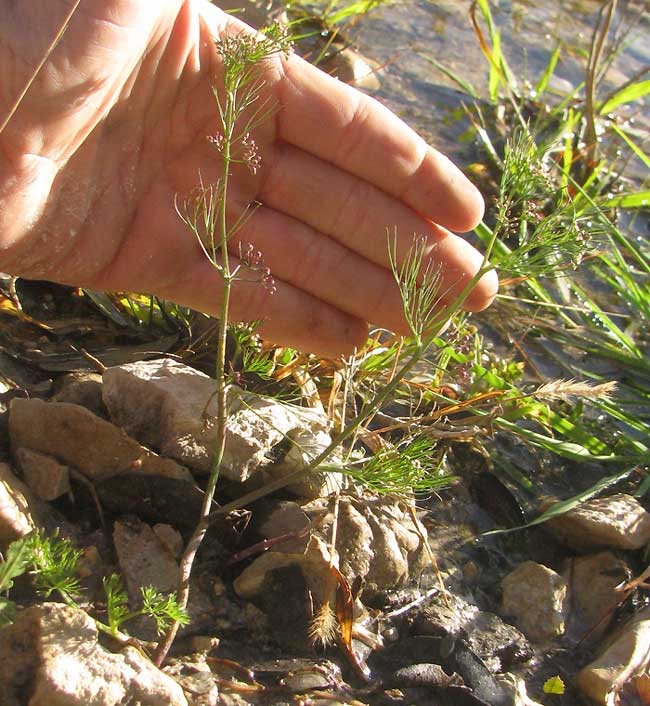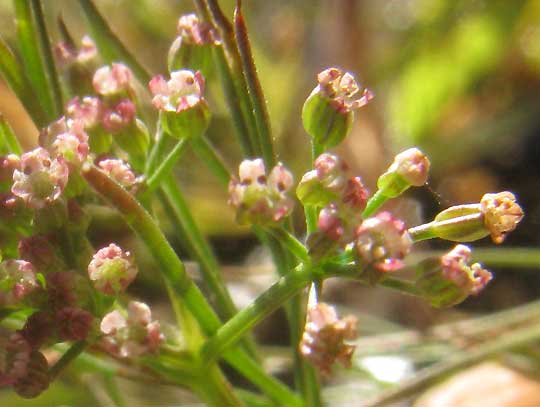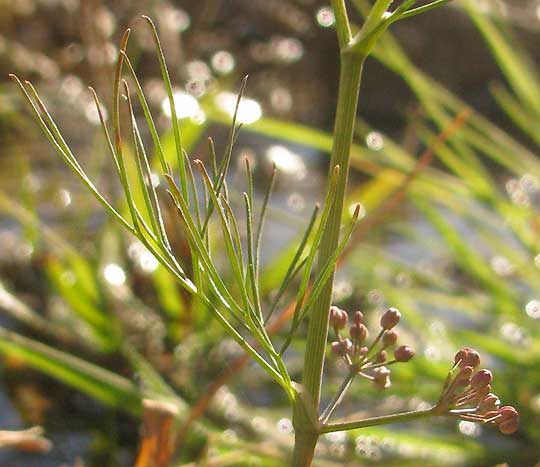Excerpts from Jim Conrad's
Naturalist Newsletter

from the January 26, 2014 Newsletter issued from the Frio Canyon Nature Education Center in the valley of the Dry Frio River in northern Uvalde County, southwestern Texas, on the southern border of the Edwards Plateau; elevation ~1750m (~5750 ft); N29.62°, W99.86°; USA
MARSH PARSLEY
To discover uncommon plants, one approach is to seek out uncommon habitats. Along the little Dry Frio River, one such habitat is where water emerges from the base of gravel bars blocking the river's flow. Flowing water disappears into the gravel upstream, then issues from it downstream. It was in mud beside a spot where water trickled from the gravel that the flowering plant turned up shown above.
Finding this plant flowering here surprised me. It's not one of those perennial wildflowers or mixed-up invasive weeds that might turn up flowering anytime during the year after a week or two or warmness, or a good rain, but rather a spring-flowering annual herb. The little herb really figured that it was springy enough to flower! A close-up of a spray of its tiny flowers can be seen below:

Each flower's five petals is white tinged with pink, and only about 0.3mm long (1/100th inch). Notice how the petals arise atop the ovary, or future fruit, making these flowers part of that minority of blossoms with "inferior ovaries." Also, notice that the flowers are arrayed in "umbels" -- more-or-less flat-topped flower clusters with all the flowers' stems, or pedicels, arising from one point. Moreover, several umbels unite to form yet a larger umbel, a "compound umbel." Whenever you see a flower cluster with this structure, the best bet is that you're dealing with what used to be called the Umbelliferae, but now is named the Apiaceae, and know commonly as the Parsley Family.
Other important field marks for identification are shown below:

First, the umbels arise on the stem opposite the leaves, and not at stem ends as with many members of this family. Second, the leaves are twice-divided, or bipinnate, and leaf parts consist of threadlike lobes. Leaves of plants in this family often are divided into tiny leaflets or threadlike sections, but this plant carries the concept to an extreme.
With such distinctive field marks this early blooming little herb was easily identifiable as Marsh Parsley, also called Fine-leaved Celery, Slender Celery, Slim-lobe Celery and other names. It's CYCLOSPERMUM LEPTOPHYLLUM, and unlike the rare native wildflower I was hoping for, it occurs worldwide in warm to tropical zones, and is considered a noxious weed in many areas. It arises from a taproot and despite our young plant's small size, it can reach knee high in height. Native to South America, in the US it's found coast-to-coast in the southern states. It thrives along streams, roadsides and in wastelands.
Why is our Marsh Parsley flowering so early? Probably water issuing from the gravel bar has been warmed by the gravel. Also, the plant grew on a south-facing slope, and our recent weather has bee unusually warm and sunny.
Despite the "celery" part of some of its common names, it's not too closely related to Celery, though it's in the same family. Its leaves taste enough like parsley to be sprinkled in salads to add a little taste. I wouldn't use much, however, since the plant really isn't known as desirable for eating.